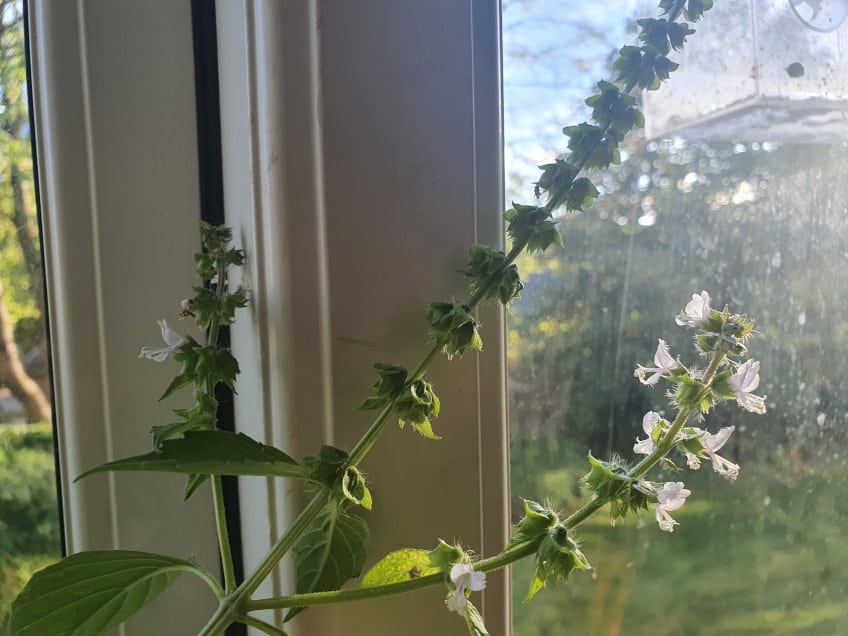When growing herbs, it can be beneficial to know in advance if they will spread. Some herbs don’t spread, but others do and eventually take over an area of the garden, so what about basil?
Does basil spread? Basil plants only spread by seed, so removing the flowers as soon as they appear will prevent the plant from spreading. However, allowing basil to go to seed does not guarantee that it will spread since the seeds can only withstand very mild frost, so in most areas, it won’t spread even by seed.
Depending on if you want your basil to spread or not, there are ways you can prevent it from spreading and ways you can help it spread if that is what you want. In this post, I explain both.

How Basil Plants Can Spread
I have been growing lots of basil over the years, so I have learned a thing or two about it, and one of the things I have noticed about basil compared to some other herbs is how the plant spreads. Or rather, how it does not spread.
Basil only spreads by producing seeds that grow as new plants. However, the seeds will only sprout if the temperature does not get too low as the seeds cannot withstand frost for an extended period of time. You can make basil spread manually by taking cuttings or collecting seeds.
Basil needs at least 6 hours of sunlight per day and warm temperatures, so in most parts of the world, the winters get too cold for basil to spread naturally, but in its native regions, which include India, Malaysia, and Western Asia (source), basil will spread naturally through seed simply by flowering, going to seed, and dropping the seeds on the ground once the plant gets dry and dies.
So if you live in an area that experiences cold winters (below freezing), you do not have to worry about your basil spreading and taking over your garden, but if you do want your basil to spread, there are also ways you can make that happen. I will describe these in this post as making your basil spread is one of the most effective ways to increase your overall basil yield.
If you live in an area where the winters don’t get too cold and there are at least 6 hours of sun per day all year, there is a decent chance that your basil will spread by itself if you allow it to go to seed, but if you want to avoid that, it is not very difficult. I will describe how below.
How to Prevent Basil from Spreading
Basil plants only spread through seed, and since those seeds are not so resistant to cold temperatures, they will only sprout in areas where they are not exposed to intense frost.
If you live in an area where basil can have good conditions all year, the seeds will most likely sprout and grow in the spring, so if you don’t want your basil to spread, this is what you should do:
To prevent basil plants from spreading, you must remove the flowers before they produce seeds. Ideally, the flowers should be removed as soon as they appear since the leaves will lose some of their taste once the plant begins to produce flowers.
Removing basil flowers guarantees that the plant won’t go to seed. At least for a while, because in my experience, the flowers will begin to grow back faster and faster once you start to remove them. Whether or not you should remove flowers from basil plants depends on what you want from the plant, but I have written another post about that, which you can find here.
I have never personally seen basil spread since the area I live in experiences frost every year, sometimes as early as October and as late as April. Additionally, the area I live in does not get nearly enough sun for basil to survive winter.
If you do want your basil plants to spread but you, like me, live in an area where it won’t happen naturally, I have two tricks for you that can make your basil plants spread quickly and effectively. I describe these below.
How to Make Basil Plants Spread

The two most straightforward ways I have found to make basil spread if you don’t live somewhere where it will happen naturally is to either take cuttings, root them in water, and plant them or collect seeds that you can use to grow many more plants.
Taking cuttings and growing them as new plants is easy. All you have to do is to cut a basil stem that is at least 5-7 inches (about 12.5-18 cm) just above a set of leaf nodes, place it in water for a few weeks until the roots grow and then plant it in soil. I have a much more detailed guide that explains all the steps which you can find here.
You can also let your basil plants flower and die. When the flowers are dry, you can easily collect the seeds from them, which you can then use to sow more plants. When your basil looks like mine in the photo above, it is almost done producing seeds. I explain how to collect the seeds in the article on this link.
Both of these ways of making basil spread are very manual, but unless you live in an area that never has frost, your plants won’t spread naturally and need some assistance.
Read My Complete Guide to Growing and Caring for Basil
I have written a thorough guide where I cover all parts of growing your own basil including choosing a variety, sowing the seeds, the best growing conditions, pruning, propagation, harvesting, storing, solving various problems, and a lot more. You can find the article on this link.
